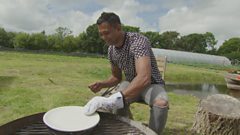
Episode 21
As Monty Don brings in the tastiest of the summer harvest, he plans for the months ahead, giving advice on what to sow now to keep the crops coming up to the end of autumn.
As Monty starts to bring in the tastiest of the summer harvest, he is planning for the months ahead as he gives advice on what to sow now to keep the crops coming up to the end of autumn. He also plans for next spring when he gives tips on saving money by propagating perennials.
Carol Klein visits a lady who is losing her eyesight and helps her organise her confused borders and give her recommendations of plants which will be a feast for her senses. Joe Swift takes a close look of the design of a contemporary country garden and Nick Bailey travels to an Essex village to meet a bunch of enthusiastic villagers who are using their gardens to help in the revival and preservation of the historic Pemberton roses. Arit Anderson meets a gardener who is looking to the future in the design and planting of his extraordinary garden, and we pay a second visit to Wales to catch up with Shaish Alam to find out how his crops have been faring in his newly planted field.
Last on
Clips
-
![]()
Shaish Alam harvests veg to cook a fresh curry
Duration: 02:20
-
![]()
Plants for free using bargain herbaceous perennials
Duration: 03:07
Fairlight End

The garden at Fairlight End sits on the edge of the Sussex Weald where it begins its descent down to the sea. The garden boasts views down the slopes over abundant borders and luxurious lawns littered with specimen trees and shrubs. Beyond are the wildflower meadows and ponds with a backdrop of a truly unspoilt landscape.
In places, the sloping ground has been cleverly tamed by corten steel wall, while decked seating areas allow you to soak in the spectacular views. Dense stands of tightly clipped alpine Pinus mugo var. mughus, form miniature woodlands around the sinuous landscaping. The garden is part of the National Garden Scheme and is open to visitors by arrangement.
Fairlight End
Pett Road
Pett
Hastings
East Sussex
TN35 4HB
(www.ngs.org.uk)
How the Pemberton rose arose

In 1911 Joseph Pemberton briefly became President of the National Rose Society for a two year period. After this, with the help of his gardener John Bentall and his wife Ann, he set about to breed varieties of roses that would out bloom his much loved grandmother's roses, which usually finished blooming by July. He wanted roses that would survive and bloom after others had finished flowering.
He originated a new group of varieties which were large bushes, in bloom more or less continuously, bearing flowers of varying size and doubleness, mostly white, pale pink and pale yellow, in gigantic clusters.
He chose Trier, a hybrid multiflora offspring of Aglaia (itself a cross of R. multiflora by the noisette Reve d'Or) as the base (mother plant) for his breeding. In 1919 he began calling his roses Hybrid Musks after Courtney Page, the then Secretary of the National Rose Society used the term in his review of Joseph Pemberton's new rose ‘Pax' in 1917. Prior to this they were still being called Hybrid Teas.
The Hall
Broxhill Road
Havering-atte-Bower
Romford
Essex
RM4 1QH
Tel: 01708 753319
(www.pembertonroses.org.uk)
John Little: Brownfield Gardener

John has dedicated his 4 acre garden in Basildon, South Essex, to experimenting with this ethos of reimagining industrial landscapes. He thinks of brownfield sites as “the rainforests of the UK”. He wants to bring brownfield design back into the landscaping of gardens.
Essex has the most brownfield sites in the UK. It’s also one of the driest areas in the UK, so could be an indicator of the possible future effects of global warming. An entomologist has studied the brownfield section of John’s garden, and confirmed it is the most biodiverse area within the 4 acre plot.
����
John likes playing with the notion that a garden can be designed by the soil rather than the plants. He uses crushed materials including crushed brick, concrete and rubble, crushed ceramics like old toilets and sinks. He’s even been known to bury the odd car in the ground… apparently rabbits, robins and wrens are more than happy to move in to a rather unconventional new home!
Credits
| Role | Contributor |
|---|---|
| Presenter | Monty Don |
| Presenter | Arit Anderson |
| Presenter | Nick Bailey |
| Presenter | Carol Klein |
| Presenter | Joe Swift |
| Series Producer | Sharon Fisher |
| Production Manager | Jennie Sawyer |
| Executive Producer | Paolo Proto |


